


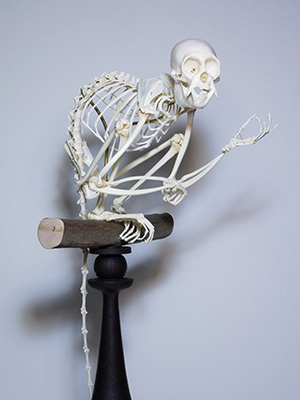
シロガオサキ
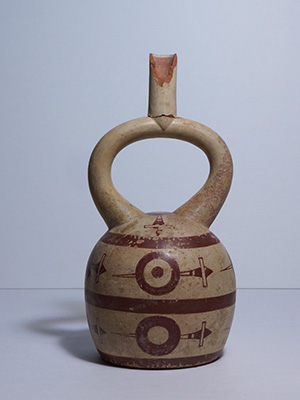
武具文様鐙型ボトル
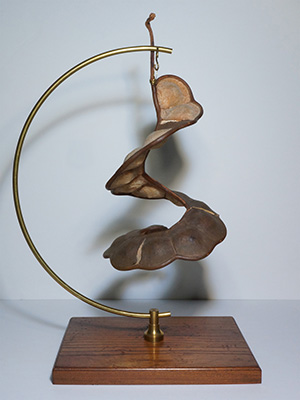
マメ科モダマ属(エンタダ・スピラリス)
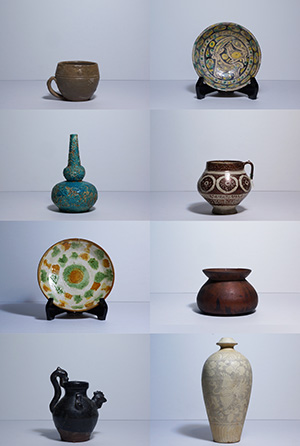
江上波夫旧蔵陶磁器
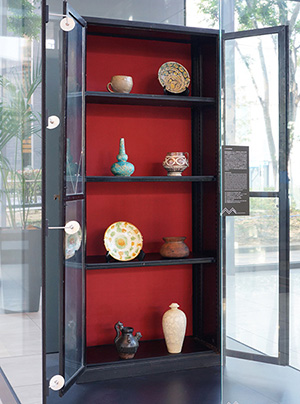
江上波夫旧蔵陶磁器の展示風景

モバイルミュージアム(赤坂インターシティ)
展示標本 (2014.11.17〜2015.7.31)
小ケース1:シロガオサキ
南米大陸北東部アマゾン川北部の熱帯雨林に生息するサルの一種。寿命は15年ほど。雌雄のペアか、5頭程度の家族単位で行動する。オスは全身が黒く長い毛で覆われるが、顔面のみ白い毛で覆われており、これが名前の由来となっている。樹層の中間部で多くの時間を過ごし地上に降りる例は非常に少ない。移動は、四肢による歩行か後肢を用いた跳躍で、時に10m近い距離を跳ねることがある。長い尾は、物を絡めとるなどはしないが樹上で行動するときのバランスをとる役目を担う。標本番号なし。
White-faced Saki (Pithecia pithecia)
A species of monkey that distributes in rain forests in Northern Amazon, South America. Making family group or male-female pair and the life span is about 15 years. Male is covered with long black fur but has white face as its name. They spend most of the time in the middle layer of the trees and seldom walk on the ground. Their locomotion is quadruped walking or jumping by hind legs, sometimes leap near 10m. The long tail stabilizes the body during moving on the twigs but can’t grasp objects.
小ケース2:武具文様鐙型ボトル
アンデス文明の多様な土器制作伝統の中でモチェ文化(1〜7世紀)は、古代人の日常生活や彼らの信じた超自然的存在を比較的写実的に描写したことで知られる。古代アンデスには文字がなかったので、これらは考古学者が当時の風習や世界観を知る上で重要である。この鐙型ボトル土器にはモチェの戦士が使った武具、円い盾と棍棒が描かれている。モチェ文化(IV期)、ペルー(5〜6世紀)、標本番号MF-03。
Stirrup-spout bottle with drawing of weapons
Though pottery-making traditions of the Andean civilization show a wide variety Moche culture (1st-7th century) is especially known for realistic depictions of the themes of daily life and supernatural beings. Because the ancient people in the Andes did not have writing systems, Moche pottery is important for archaeologists to understand the customs and cosmologies of ancient Andean people. The drawing on this stirrup-spout bottle represents weapons, circular shields and clubs, which were used by Moche warriors. Moche culture (Phase IV), Peru (5th-6th century).
小ケース3:マメ科モダマ属(エンタダ・スピラリス)
東南アジアの常緑広葉樹林内に生えるマメ科モダマ属のつる性木本。螺旋状の巨大なさやにちなんで、“スピラリス”の名が付けられた。モダマ属は熱帯・亜熱帯を中心に世界に約30種が知られるが、このように美しい螺旋のさやをつけるのは本種だけである。さやは節で少しくびれ、節と節のあいだ(小節果)の膨らんだ部分には大きな種子が一つずつ入っている。さやが熟すと、節で切れてばらばらになり、種子は小節果ごと地面に落ちて散布される。本標本は1994年にタイ王国チェンマイで採集された。標本番号なし。
Entada spiralis Ridl.
Entada spiralis (Fabaceae) is a woody climber in evergreen forests in Southeast Asia. The name “spiralis” refers to the large, spiral legume (fruit) of this species. The genus Entada consists of about 30 species restricted to the world’s tropics and subtropics, but only Entada spiralis bears such a beautiful spiral legume. Each segment between the constrictions of the legume contains one seed. When mature, the segments, each enveloping its seed, separate and fall to the ground. This specimen was collected in Chiang Mai, Thailand, in 1994.
中ケース:江上波夫旧蔵陶磁器
騎馬民族征服王朝説やチンギス・ハーン陵墓の探索などで著名な江上波夫名誉教授の旧蔵陶磁器である。教授による、ユーラシアを中心としたフィールドワークを物語るように、これらのうつわは、煤など使用痕のみられる日用品(EG04.2)から、副葬品と考えられるもの(EG03.539)、注ぎ口が釉薬で埋まり、おそらくは実用以外の目的のために作られた水差し(EG03.489)など、その用途はさまざまながら、産地はすべてユーラシアにもとめることができる。これらのうつわの中には、牡丹や鳥といった、身近な動植物や(EG03.462、EG03.536)、文字状の模様(倣文字)(EG03.536)、ぶどう唐草に「福」「禄」の文字(EG03.461)など、細やかな装飾をみせるものがある。牡丹、ぶどう唐草などは吉事の前兆とされる、いわゆる吉祥のモチーフであり、イスラム陶器にみられる文字装飾は、箴言や祝福、コーランにちなんだことばがもちいられることもあった。このように、うつわの装飾の表現には、たんに鑑賞目的のみならず、しばしば理想や願望など観念的な意味も込められることがあった。
Vessels of Eurasia
This is a selected collection of pottery and ceramic vessels from the Namio Egami Collection. It consists of antiques originating from regions across Eurasia: West Asia (EG03.545, 462), Central Asia (EG03.461), Southeast Asia (EG03.2, 489), and the Far East (EG03.536, 539, 546); and from different periods between the 4th (EG03.539) and 13th/14th centuries AD (EG03.545). The large variation of forms and decorations reflects regional traditions as well as different purposes: in addition to vessels for daily use, those for mortuary (EG03.539) and ritual uses (EG03.489) are also included. The vessel used for the latter has a spout filled with glaze, making it unavailable for actual use. The decorations include those representing ideological meanings. Motifs such as peony (EG03.462) and a grape-patterned arabesque (EG03.461) are symbols of favorable auspices, while ornamental letters on Islamic vessels (EG03.536) are often associated with passages from the Koran.
1段左:把手付陶質土器 朝鮮半島南部 三国時代 142×115×98
1段右:多彩鳥獣文鉢 イラン東部 10-11世紀 径192×高70
ニーシャープール出土か
2段左:青釉瓢形壷 中央アジア? 径128×高207 香油もしくは香水瓶か
2段右:ラスター彩把手付壺 イラン 13-14世紀
3段左:三彩盤 中国北部・内蒙古 遼時代 径217×高50 磁州窯系
3段右:土器 タイ東北部 径167×112
4段左:黒褐釉天鶏壷 タイまたはカンボジア 中国 11世紀末-13世紀 156×125×194
4段右:白地線彫鳳凰文梅瓶 中国、北宋-金時代 径134×高268
総合監修
西野 嘉章(本館館長・教授、美術史学、博物館工学)
解説文執筆
中坪 啓人(本館特任研究員、動物学) シロガオサキ
松原 始 (本館特任助教、動物行動学) シロガオサキ
鶴見 英成(本館助教、アンデス考古学、文化人類学) 武具文様鐙型ボトル
郄山 浩司(本館特任助教、植物系統進化学) マメ科モダマ属
三國 博子(本館教務補佐員) 江上波夫旧蔵陶磁器
西秋 良宏(本館教授、先史考古学) 江上波夫旧蔵陶磁器
協力
諏訪 元 (本館教授、形態人類学)
清田 馨 (本館技術補佐員)
佐々木猛智(本館准教授、動物分類学、古生物学)
宮本 英昭 (本館准教授、固体惑星科学)
池田 博 (本館准教授、植物分類学)
関岡 裕之 (本館特任准教授、博物館デザイン)
白石 愛 (本館特任助教、博物資源学)
菊池 敏正 (本館特任助教、文化財保存学)
寺田 鮎美 (本館特任助教、文化政策、博物館論)
写真撮影
松本 文夫 (本館特任准教授、建築学)
他の展示期間の展示物
2007年1月〜2007年7月
2007年7月〜2008年2月
2008年2月〜2008年8月
2008年8月〜2009年2月
2009年2月〜2009年7月
2009年8月〜2010年1月
2010年2月〜2010年7月
2010年8月〜2011年1月
2011年1月〜2011年7月
2011年8月〜2012年1月
2012年1月〜2012年7月
2012年8月〜2013年2月
2013年2月〜2013年8月
2013年8月〜2014年1月
2014年2月〜2014年11月
2014年11月〜2015年7月
2015年8月〜2016年1月
2016年2月〜2016年7月
今までのトップページの連続スライドショー
新日鉄興和不動産本社におけるモバイルミュージアム(非公開)
ページの先頭に戻る